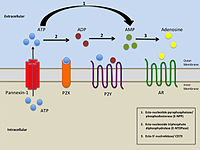
Photo from wikipedia
Adenosine is known to be released under a variety of physiological and pathophysiological conditions to facilitate the protection and regeneration of injured ischemic tissues. The activation of myocardial adenosine A1 receptors… Click to show full abstract
Adenosine is known to be released under a variety of physiological and pathophysiological conditions to facilitate the protection and regeneration of injured ischemic tissues. The activation of myocardial adenosine A1 receptors (A1Rs) has been shown to inhibit myocardial pathologies associated with ischemia and reperfusion injury, suggesting several options for new cardiovascular therapies. When full A1R agonists are used, the desired protective and regenerative cardiovascular effects are usually overshadowed by unintended pharmacological effects such as induction of bradycardia, atrioventricular (AV) blocks, and sedation. These unwanted effects can be overcome by using partial A1R agonists. Starting from previously reported capadenoson we evaluated options to tailor A1R agonists to a specific partiality range, thereby optimizing the therapeutic window. This led to the identification of the potent and selective agonist neladenoson, which shows the desired partial response on the A1R, resulting in cardioprotection without sedative effects or cardiac AV blocks. To circumvent solubility and formulation issues for neladenoson, a prodrug approach was pursued. The dipeptide ester neladenoson bialanate hydrochloride showed significantly improved solubility and exposure after oral administration. Neladenoson bialanate hydrochloride is currently being evaluated in clinical trials for the treatment of heart failure.
Journal Title: ChemMedChem
Year Published: 2017
Link to full text (if available)
Share on Social Media: Sign Up to like & get
recommendations!